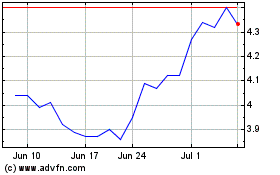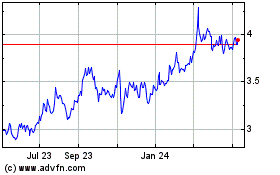Wall Street was a heavy user of the Federal Reserve's
extraordinary credit facilities during the financial crisis, Fed
data released Wednesday showed.
Goldman Sachs Group Inc. (GS), for instance, tapped the Fed's
Primary Dealer Credit Facility 84 times. Morgan Stanley (MS)
borrowed from the Fed's Primary Dealer Credit Facility 212 times
between March 2008 and March 2009, an indication of just how close
Wall Street's second-largest investment bank came to the brink of
collapse during the financial crisis.
The Fed created the Primary Dealer Credit Facility, or PDCF, to
provide discount window loans to investment banks, a privilege
previously reserved for more tightly regulated commercial banks.
Eventually both Goldman Sachs and Morgan Stanley were granted bank
holding company status.
Commercial banks also were big users of the facilities, often
through their investment banking arms.
Citigroup Inc. (C) used the Primary Dealer Credit Facility
almost daily through its investment banking unit, borrowing as much
as $17.9 billion in late November 2008, around the time the
government stepped in to prevent Citi's cardiac arrest. The use
tapered off in April 2009.
Bank of America Corp. (BAC) used the PDCF nearly every trading
day from Sept. 18, 2008, to May 12, 2009, more than 1,000 times in
total. The bank's single biggest use of the facility was for $11
billion in October 2008, and seven times it took more than $10
billion at a time.
From the PDCF, J.P. Morgan Chase & Co. (JPM) appeared to use
the funding as a parent company far fewer times than rivals, only
using it once in September 2008 and twice in October 2008. However,
the Fed's data also show Bear Stearns & Co. used the facility
almost daily from April 2008 to late June 2008, after J.P. Morgan
had bought the investment bank in March of that year, but before
the extra funding from the government closed.
A Morgan Stanley spokesman said the company "utilized some of
the Federal Reserve's emergency lending facilities during a time of
immense financial turmoil throughout the banking sector and the
broader market. The loans, which were fully collateralized to the
requirements of each Fed facility, were fully repaid."
Goldman spokesman Michael DuVally said, "In late 2008 many of
the U.S. funding markets were clearly broken. The Fed took
essential steps to fix these markets and its actions were very
successful."
Citigroup said, "The programs offered were meant to provide
liquidity backstops as well as instill confidence in the market.
They achieved these goals. Citi's usage of these programs was
appropriate at the time."
Bank of America spokesman Robert Stickler said in a statement
the "programs helped our customers such as borrowers, auto dealers,
depositors and money market fund investors continue to do business
as usual despite virtually unprecedented disruptions in the
financial markets. We have repaid, with interest, all of the
borrowings except some of those whose terms have not expired."
Foreign Banks
Foreign banks also appear on the list of those using the PDCF
multiple times, including Barclays PLC (BCS, BARC.LN), BNP Paribas
(BNPQY, BNP.FR), Mizuho Financial Group's (MFG, 8411.TO) U.S.
securities unit, and UBS AG (UBS, UBSN.VX).
Among those using it only once were Deutsche Bank AG (DB,
DBK.XE), Daiwa and Dresdner Kleinwort.
Among the banks that acted as primary dealers in 2008, HSBC
(HBC, HSBA.LN) does not appear on the list of those that used the
facility.
Primary dealers trade U.S. government securities with the Fed
and basically act as a global distribution network for Treasury
securities. There are currently 18 of them. Four dropped off the
list in 2008, including Lehman, Countrywide Financial, Bear Stearns
and Merrill Lynch, and three have joined the group since then,
Nomura (NMR, 8604.TO) being the most recent.
Other Lending Programs
The Federal Reserve began in December 2007 announcing a series
of emergency programs aimed at easing a severe credit crunch. Wall
Street firms were heavy users of other programs as well. The Term
Auction Facility, or TAF, for instance, allowed banks to bid for
loans without the stigma associated with the Fed's discount
window.
Citi accessed TAF through its two banking charters 26 times
between January 2008 and July 2009; its largest TAF loan was $15
billion. Although several borrowings were considerably less, Citi
did take out four loans for $10 billion each the last four time it
used TAF.
Bank of America tapped TAF 15 times from October 2008 to May
2009. The first time it took $2.2 billion in September 2008 and
every other time the loan was for $15 billion.
J.P. Morgan used the TAF seven times with the largest loan being
$15 billion in February 2009. Chief Executive Jamie Dimon had told
investors in 2009 the bank used TAF "at the request of the Federal
Reserve to help motivate others to use the system."
Another facility, the Term Securities Lending Facility, or TSLF,
loaned up to $200 billion in Treasury securities to investment
banks for long, 28-day periods.
Citigroup used the TSLF 65 times, and its largest single
borrowing under that program was for $10 billion, in May 2009. J.P.
Morgan used the TSLF 23 times, never taking more than $5 billion at
a time.
Bank of America used the TSLF 23 times, with the high-water mark
an $8.75 billion loan. Morgan Stanley also used the TSLF 34 program
times and its largest single loan was $10 billion.
Shares of large banks were up in afternoon trading Wednesday
amid a generally buoyant market. Shares of Citigroup were up 2.6%
to $4.31, J.P. Morgan rose 2% to $38.14, Goldman Sachs shares were
up 1.5% to $158.44 and Morgan Stanley rose 1.8% to $24.90.
-By Liz Moyer, Brett Philbin, Dave Benoit and Matthias Rieker,
Dow Jones Newswires; 212-416-2512; liz.moyer@dowjones.com
(Maya Jackson Randall contributed to this report.)
Mizuho Financial (NYSE:MFG)
Historical Stock Chart
From May 2024 to Jun 2024

Mizuho Financial (NYSE:MFG)
Historical Stock Chart
From Jun 2023 to Jun 2024
